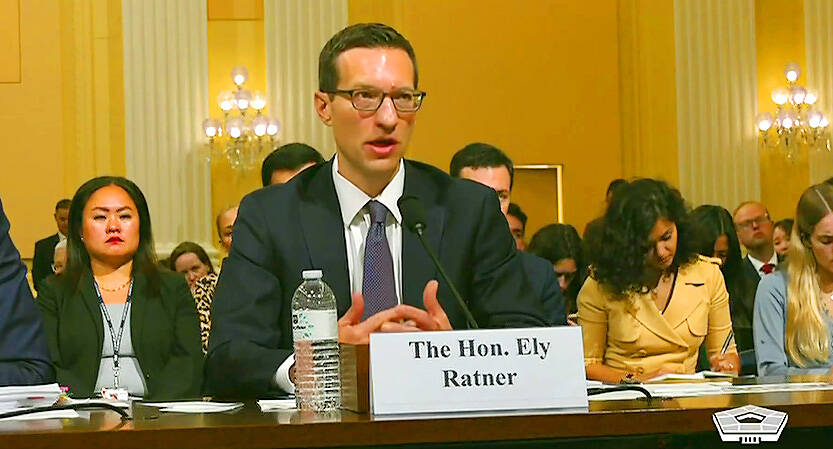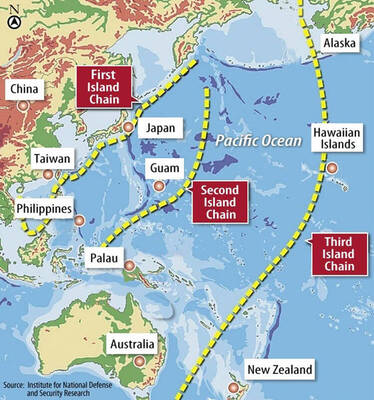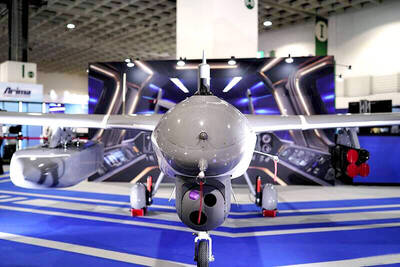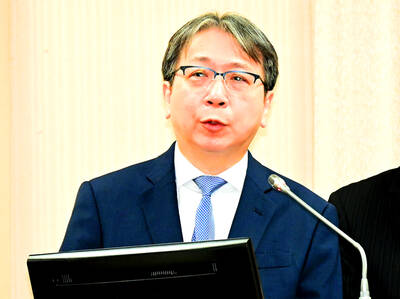Washington will expedite arms sales to Taiwan through various means including the presidential drawdown authority, US Assistant Secretary of Defense for Indo-Pacific Affairs Ely Ratner said on Thursday.
Ratner was speaking at a hearing held by the US House of Representatives’ Select Committee on the Strategic Competition between the US and the Chinese Communist Party to discuss US President Joe Biden’s China strategy.
Asked about the delay in delivering weapons to Taiwan, Ratner said: “What we are facing is not a backlog as is sometimes described, but rather concerns and slowdowns within all of our industrial base.”

Photo: Screen grab from a video on the US Department of Defense’s Web site
It is a systemic problem that is affecting not only Taiwan, but military production in the US defense industrial base, he said.
“We’re doing everything we can to fulfill our commitments under the Taiwan Relations Act [TRA] as quickly as we can” through foreign military sales, presidential drawdown authority and potentially foreign military financing, he said.
As part of the National Defense Authorization Act for Fiscal Year 2023, the US Congress authorized up to US$1 billion of weapons aid for Taiwan using the presidential drawdown authority, which authorizes the president to transfer weapons and services from US stockpiles without congressional approval during an emergency.
The US “will soon provide significant additional security assistance to Taiwan through the presidential drawdown authority that Congress authorized last year,” US Secretary of Defense Lloyd Austin told Congress in May.
“Providing these self-defense capabilities to Taiwan is one of the department’s highest priorities,” Ratner said.
“The TRA has formed the bedrock of peace, stability and deterrence in the Taiwan Strait over the last four decades,” he said.
“We’re absolutely committed to ... meeting our commitments under the Taiwan Relations Act to assist Taiwan to maintain sufficient self-defense capability. We’ll meet those obligations,” US Assistant Secretary of State for East Asian and Pacific Affairs Daniel Kritenbrink told the hearing.
On US-Taiwan economic relations, US Representative Michelle Steel said that the initial trade agreement reached under the US-Taiwan Initiative on 21st-Century Trade, which the US Senate passed on Tuesday, was welcomed, but “it’s still [a] very tiny bit, so we really have to extend that.”
Asking why Taiwan is not included in the Indo-Pacific Economic Framework (IPEF), she said: “Why leave them [Taiwan] out of the IPEF if they are a like-minded, true ally.”
Kritenbrink said that the US is focusing on the 14 partners currently in the IPEF, but reaffirmed Washington’s promise to Taiwan.
“We’re very committed to building our partnership with Taiwan, our very important, robust, but unofficial partnership,” and will continue to do so, he said.
Additional reporting by CNA

The US government has signed defense cooperation agreements with Japan and the Philippines to boost the deterrence capabilities of countries in the first island chain, a report by the National Security Bureau (NSB) showed. The main countries on the first island chain include the two nations and Taiwan. The bureau is to present the report at a meeting of the legislature’s Foreign Affairs and National Defense Committee tomorrow. The US military has deployed Typhon missile systems to Japan’s Yamaguchi Prefecture and Zambales province in the Philippines during their joint military exercises. It has also installed NMESIS anti-ship systems in Japan’s Okinawa

‘WIN-WIN’: The Philippines, and central and eastern European countries are important potential drone cooperation partners, Minister of Foreign Affairs Lin Chia-lung said Minister of Foreign Affairs Lin Chia-lung (林佳龍) in an interview published yesterday confirmed that there are joint ventures between Taiwan and Poland in the drone industry. Lin made the remark in an exclusive interview with the Chinese-language Liberty Times (the Taipei Times’ sister paper). The government-backed Taiwan Excellence Drone International Business Opportunities Alliance and the Polish Chamber of Unmanned Systems on Wednesday last week signed a memorandum of understanding in Poland to develop a “non-China” supply chain for drones and work together on key technologies. Asked if Taiwan prioritized Poland among central and eastern European countries in drone collaboration, Lin

ON ALERT: Taiwan’s partners would issue warnings if China attempted to use Interpol to target Taiwanese, and the global body has mechanisms to prevent it, an official said China has stationed two to four people specializing in Taiwan affairs at its embassies in several democratic countries to monitor and harass Taiwanese, actions that the host nations would not tolerate, National Security Bureau (NSB) Director-General Tsai Ming-yen (蔡明彥) said yesterday. Tsai made the comments at a meeting of the legislature’s Foreign Affairs and National Defense Committee, which asked him and Minister of National Defense Wellington Koo (顧立雄) to report on potential conflicts in the Taiwan Strait and military preparedness. Democratic Progressive Party (DPP) Legislator Michelle Lin (林楚茵) expressed concern that Beijing has posted personnel from China’s Taiwan Affairs Office to its

BACK TO WORK? Prosecutors said they are considering filing an appeal, while the Hsinchu City Government said it has applied for Ann Kao’s reinstatement as mayor The High Court yesterday found suspended Hsinchu mayor Ann Kao (高虹安) not guilty of embezzling assistant fees, reducing her sentence to six months in prison commutable to a fine from seven years and four months. The verdict acquitted Kao of the corruption charge, but found her guilty of causing a public official to commit document forgery. The High Prosecutors’ Office said it is reviewing the ruling and considering whether to file an appeal. The Taipei District Court in July last year sentenced Kao to seven years and four months in prison, along with a four-year deprivation of civil rights, for contravening the Anti-Corruption